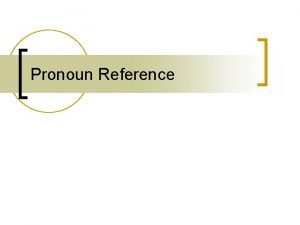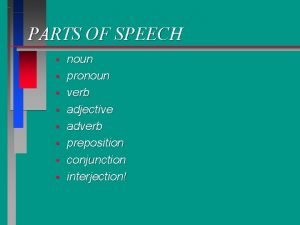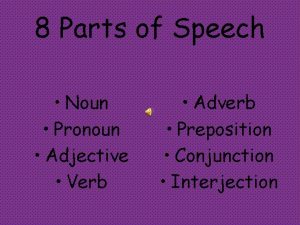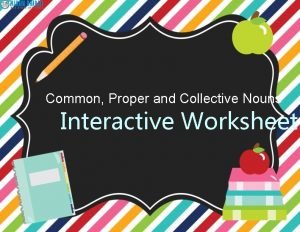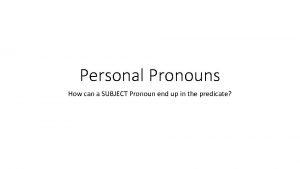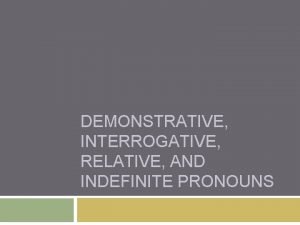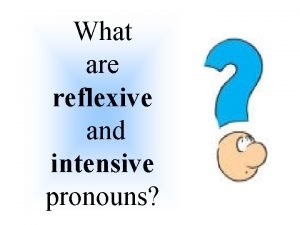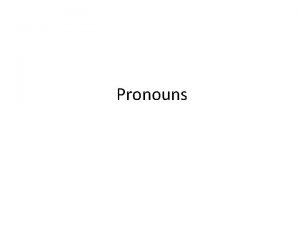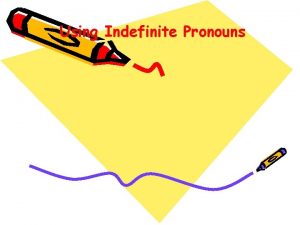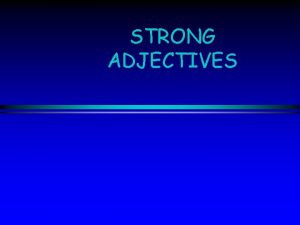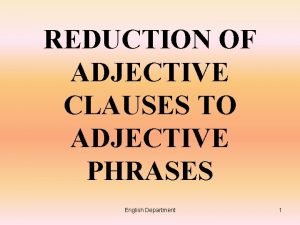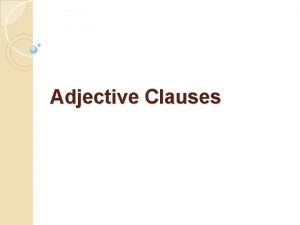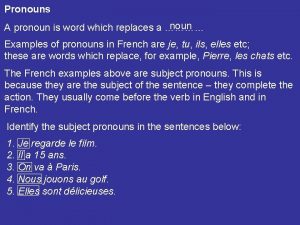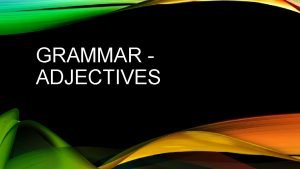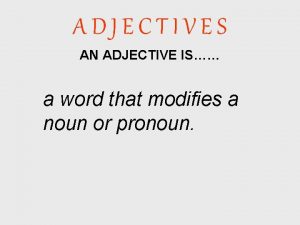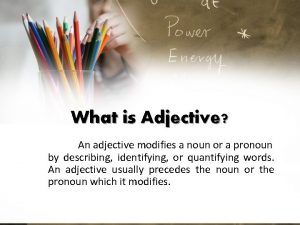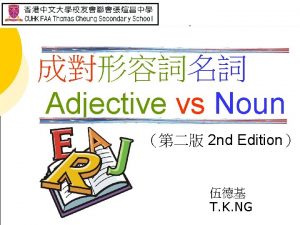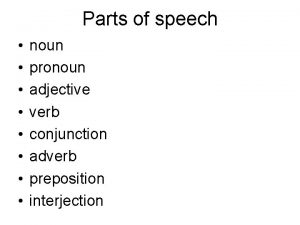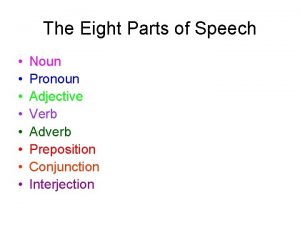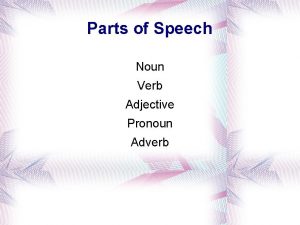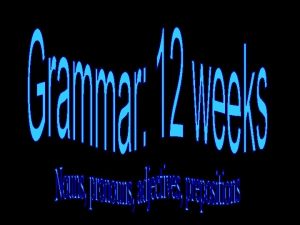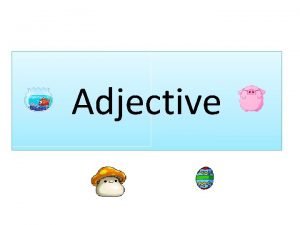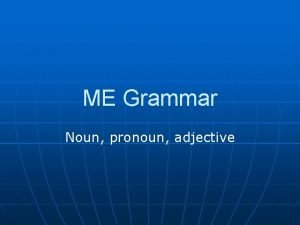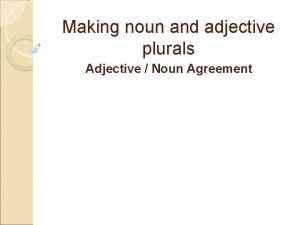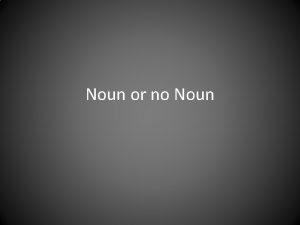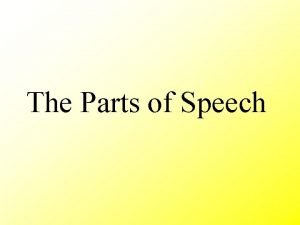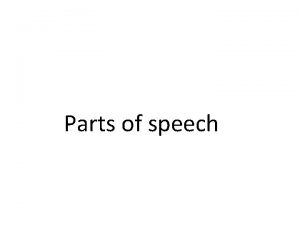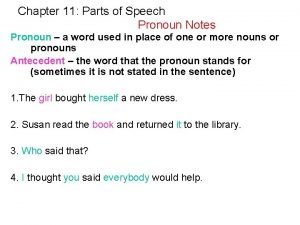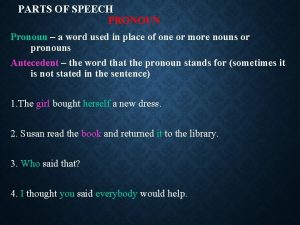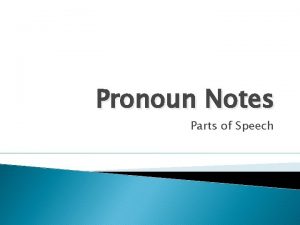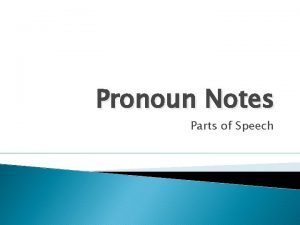GST 102 PARTS OF SPEECH Noun Pronoun Adjective


















- Slides: 18

GST 102

PARTS OF SPEECH • • Noun Pronoun Adjective Verb Adverb Conjunction Preposition Interjection

Noun • A noun is a word that names/ it is a naming word. It names person, places, things, ideas, etc. Types of Noun • A. Proper Nouns: These are names of people, place, countries, months, days, magazines, festivals, geographical features, family relations, continents, etc. They have specific reference. • B. Common Nouns: refers to entities, objects and places that have a general reference. They sub-divided into • i. Concrete: are nouns that can be seen/touched. They are tangible and exist physically. E. g. pot, fan, key, pen. • ii. Abstract: are nouns that cannot be seen/touched. They are non-material things like qualities, states, ideas etc. E. g. wisdom, love, joy, peace, happiness, beauty, kindness.

Noun (Contd. ) • Nouns can also be Count (Countable) or Non-Count (Uncountable) • Count Nouns are countable individual materials/objects. They have both singular and plural. • Non-Count Nouns cannot be counted or constitute an undifferentiated mass. E. g. furniture, equipment, information, water, oil, progress, courage, anger. They do not take the ‘s marker of plurality even when they express a plural sense. They also have measures. E. g. a litre of oil, a bucket of water, a kilo of meat, a piece of information, a loaf of bread. • Then there is also a class of Noun called Collective Noun or group nouns. E. g. a herd of cattle, a school of fish, a pride of lions, a bunch of keys, a team of players, staff, cattle.

Pronoun A pronoun is used instead of a noun. It replaces or stands for a noun. Examples are: he, she, it, they, them, I, somebody, anybody. Types of Pronoun Personal Pronoun – I, you, me, it, they, us, them Possessive Pronoun – my, mine, ours, yours, his, hers, theirs Reciprocal Pronoun – each other, one another Reflexive Pronoun - refers back to a noun e. g. myself, himself, themselves, herself, itself Relative Pronoun – used to introduce relative clauses. E. g. who, which, whom, whose Interrogative Pronoun – are used to ask questions. E. g. who, which, whom, whose Demonstrative Pronouns – this, these, that, those. Partitive Pronouns – something, anything, nothing, some, any Universal Pronouns – each, all, everybody, everyone, everything Correlative Pronouns – neither-nor, either-or

Adjective • An adjective is used to describe a noun. This means that it modifies or gives more information about a noun. Examples are: black, shallow, tall, short, perfect, skinny, beautiful. • Adjectives have the presence of suffixes that mark degree. These are base, base+-er, base+est – tall, taller, tallest; fast, faster, fastest. • Some other adjectives – those whose base end with –ous – use pre-modifiers ‘more’ and ‘most’ in their comparative and superlative forms. E. g. courageous, virtuous, superfluous, generous. • There also irregular adjectives. They do not reflect the base. E. g. good, bad,

Verbs • A verb is an action word. It is used to indicate the action of a verb. Examples are: jump, shout, shoot, kiss, go. • Verbs can be classified in the following ways: • Lexical and Auxiliary – the lexical verb can stand on its own. It does not depend on another word before it is understood. E. g. jump, hit, push. • Auxiliary verbs rely on and are used with the lexical verbs. Also called a helping verb. Auxiliaries can be split into two: Primary/Non-Modal Auxiliary – Be, Have, Do. • Modal Auxiliary – Can, Could, May, Might, Shall, Should, will, would, must, ought to,

Verbs (Contd. ) • Verbs have five forms – base, -s, -ed (past tense), -ing, ed 2/en (participial) • Regular and Irregular: Regular verbs are predictable as their past tense and participial are formed with the addition of ‘-ed’. • Irregular verbs do not have ‘ed’ in forming their past and participial. E. g. hit, burst, broadcast, kneel, fight, give, drink, fall. • Finite and Non-Finite: Finite verbs show tense, number, concord and mood. E. g. We are one. It is mine. We sell books. • Non-Finite verbs do not show tense, number, concord and mood. E. g. Tired, he/they/I went to sleep. To err is human.

Adverb • Adverbs are used to modify verbs. They show the degree or extent of the action expressed by a verb. Most adverbs end with ‘-ly’. Examples are: slowly, quickly, intensely, strongly, quietly, seriously, brightly, fast, completely, speedily. • He walked slowly; she wrote passionately, • Adverbs also modify adjectives – really beautiful, intensely arousing, seriously, highly inspiring. • And another adverb – truly carefully planned

Conjunction • This is used to connect or link words, phrases, clauses, sentences and even paragraphs together. They are also called connectors. Examples are: and, but, or, because, although, while. • There are coordinating conjunctions. These are used to link words, phrases and clauses of the same rank. The three coordinators in English are And, But, Or. • Subordinating conjunctions introduce a clause that is in subordination to a superordinate or main clause. E. g. Because she is beautiful, many men wanted her. Since they resumed, classes have been hectic. When it is raining, one needs an umbrella.

Preposition • It is used to show the relationship between a word another within a sentence. It is used to link or locate two nouns. Examples are: in, at, under, behind, beside, for, with, against, on, through, above, along with. • E. g. I left the pen in my pocket • The teacher is around the corner.

Interjection • This is used to express an outburst of feelings or emotions like surprise, delight, anger, pain, etc. Examples are: whoa! Ouch! Ha! Uhm! Yes! Great! Incredible! How nice!

Matters Arising • Some words are malleable as they can be used for different words classes. • Perfect • Invite • Export • Not all words with ‘ly’ ending is an adverb. E. g. Deadly – deadlier, deadliest.

Sentence: Types and Functions • A sentence is a string of words that make a complete and unified sense. A sentence is composed of one or more clauses. A clause contains a subject and verb. • There are two types of clauses: independent clauses and dependent clauses. • A sentence contains at least one independent clause and may contain one or more dependent clauses. • An independent clause (or main clause) is a complete thought. It can stand by itself. • A dependent clause (or subordinate clause) is an incomplete thought. It cannot stand by itself. • You can spot a dependent clause by identifying the subordinating conjunction. A subordinating conjunction creates a dependent clause that relies on the rest of the sentence for meaning.

Types of Sentence • Sentences are divided into four categories according to structure: simple sentences, compound sentences, complex sentences, and compound-complex sentences. • A simple sentence contains one independent clause. • A compound sentence contains two independent clauses. A coordinating conjunction (and, but, or, nor) often links the two independent clauses and is preceded by a comma. • A complex sentence contains one independent clause and one or more dependent clauses. A complex sentence will include at least one subordinating conjunction. • A compound-complex sentence combines complex sentence and compound sentence forms. A compoundcomplex sentence contains one or more independent clauses and one or more dependent clauses.

Functions of Sentence A sentence can communicate : • A statement (I am studying. ) - Declarative • A command (Go away. ) - Imperative • An exclamation (I’m so excited!) - Exclamatory • A question (What time is it? ) – Interrogative • A wish - Optative • A good sentence must have unity (single idea), coherence (logical and related) and emphasis. • My lecturer is an interesting person who comes to classes regularly and teaches us well.

The Paragraph • A paragraph is one of several distinct subdivisions of a text intended to separate ideas; the beginning is usually marked by a new indented line. It is a combination of sentences dealing with a single theme/focus. • The length of a paragraph is not rule-bound. However, seven to eleven sentences or eight to eleven lines are deemed ok for a paragraph. • The features of a paragraph are: • Topic sentence and Developmental/Supporting sent. • Cohesion (pronouns, conjunction, articles, etc. ) • Thematic Unity/ Coherence

Paragraph (Contd. ) • Functions of paragraphs: • Introductory paragraph • Main/Transitional paragraph • Concluding paragraph • How to show paragraphs in writing: • Indention/Indented paragraph • Block paragraph • Headed paragraph
 A list of pronouns
A list of pronouns What is a noun pronoun verb adjective and adverb
What is a noun pronoun verb adjective and adverb Noun pronoun adjective verb
Noun pronoun adjective verb Collective noun for cereal
Collective noun for cereal Subject and object
Subject and object Possessive and relative pronouns
Possessive and relative pronouns Predicate pronouns
Predicate pronouns Interrogative and relative pronouns examples
Interrogative and relative pronouns examples Reflexive pronouns
Reflexive pronouns Proper adjective for hawaii
Proper adjective for hawaii Indefinite adjectives and pronouns
Indefinite adjectives and pronouns Base strong adjectives
Base strong adjectives Restrictive clause
Restrictive clause Changing adjective clause to adjective phrase
Changing adjective clause to adjective phrase Adjective clause with preposition
Adjective clause with preposition Noun-pronoun agreement examples
Noun-pronoun agreement examples An adjective modifies a
An adjective modifies a A word that modifies a noun or pronoun
A word that modifies a noun or pronoun Adjective modifies a noun
Adjective modifies a noun
